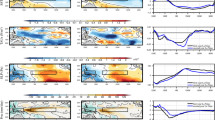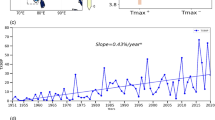Abstract
It has been shown that the abnormal rainfall in the catchment of the Amur river in 2013 had a monsoon nature. The origin and evolution of the Asian monsoon (AM) from the region of its formation in the western Indian Ocean to the penetration to Northern Asia have been analyzed. It has been shown that the indices of the Indian Ocean dipole, El Niño, and the North Pacific indices were in phases that contributed not only to maximization of its intensity, but also to the fastest possible movement of the AM from the region of origin through the Indian subcontinent, Southeast Asia, and China to the Russian Far East. Due to the current composition of the climate indices in the Indian and Pacific oceans, the overwetted monsoon air mass brought the minimum possible loss of precipitation on its way to the final region. Increased monsoon precipitation in the vast catchment of the Amur river was facilitated by the fact that the Arctic Oscillation was in the negative phase, which led to the transfer of cold arctic air into the region. The latter circumstance influenced an increase in precipitation through the mechanism of accelerated condensation in humid air. Negative values of the North Pacific indices contributed to the development of blocking situations in the zonal current of temperate latitudes, which localized the zone of precipitation.













Similar content being viewed by others
REFERENCES
Ashok, K., Guan, Z., and Yamagata, T., Impact of the Indian Ocean dipole on the relationship between the Indian Monsoon rainfall and ENSO, Geophys. Res. Lett., 2001, vol. 26, pp. 4499–4502.
Chang, C.P., Zhang, Y.S., and Li, T., Interannual and interdecadal variations of the East Asian summer monsoon and tropical Pacific SSTs. Part I: Roles of the subtropical ridge, J. Clim., 2000, vol. 13, pp. 4310–4325.
Gong, D.-Y., Wang, S.W., and Zhu, J.H., East Asian winter monsoon and Arctic Oscillation, Geophys. Res. Lett., 2001, vol. 28, pp. 2073–2076. https://doi.org/10.1029/2000GL012311
Halpert, M.S. and Ropelewski, C.F., Surface temperature patterns associated with the Southern Oscillation, J. Clim., 1992, vol. 5, pp. 577–593.
Huang, R. and Wu, Y., The influence of ENSO on the summer climate change in China and its mechanism, Adv. Atmos. Sci., 1989, vol. 6, pp. 21–32.
Kalnay, E., Kanamitsu, M., Kistler, R., et al., The NCEP/NCAR 40-year reanalysis project, Bull. Am. Meteorol. Soc., 1996, vol. 77, pp. 437–471.
Latif, M. and Barnett, T.P., Causes of decadal climate variability over the North Pacific and North America: Dynamics and predictability, J. Clim., 1996, vol. 9, pp. 2407–2423.
Mantua, N.J., Hare, S.R., Zhang, Y., et al., A Pacific interdecadal climate oscillation with impacts on salmon production, Bull. Am. Meteorol. Soc., 1997, vol. 78, pp. 1069–1079.
Meehl, G.A., The annual cycle and interannual variability in the tropical Pacific and Indian Ocean region, Mon. Weather Rev., 1987, vol. 115, pp. 27–50.
Minobe, S., A 50–70-year climatic oscillation over the North Pacific and North America, Geophys. Res. Lett., 1997, vol. 24, pp. 683–686.
North, G.R., Bell, T.L., Cahalan, R.F., and Moeng, F.J., Sampling errors in the estimation of empirical orthogonal functions, Mon. Weather Rev., 1982, vol. 110, pp. 699–706.
Overland, J.E., Adams, J.M., and Bond, N.A., Decadal variability of the Aleutian Low and its relation to high latitude circulation, J. Clim., 1999, vol. 12, pp. 1542–1548.
Pokrovsky, O.M., South European rain rate modulation by NAO and changes in atmospheric circulation regimes caused by climate warming, Comput. Geosci., 2009, vol. 35, pp. 897–906.
Pokrovsky, O.M., Detection of the spatial anomalies in the North Pacific SST field to forecast extreme monsoon rain area extension to the Northern Asia, Proc. Fifth THOR-PEX-Asia Science Workshop, 4–6 November 2013, Seogwipo, Jeju, Korea, Seoul: Korea Meteorological Administration, 2013, pp. 033–045.
Thompson, D.W.J. and Wallace, J.M., The Arctic Oscillation signature in the wintertime geopotential height and temperature fields, Geophys. Res. Lett., 1998, vol. 25, pp. 1297–1300.
Torrence, C. and Webster, P.J., Interdecadal changes in the ENSO-monsoon system, J. Clim., 1999, vol. 12, pp. 2679–2690.
Trenberth, K.E. and Hurrel, J.W., Decadal atmosphere–ocean variations in the Pacific, Clim. Dyn., 1994, vol. 9, pp. 303–319.
Wallace, J.M. and Gutzler, D.S., Teleconnections in the geopotential height field during the Northern Hemisphere winter, Mon. Weather Rev., 1981, vol. 109, pp. 784–812.
Wu, L. and Li, C., Warming of the North Pacific Ocean: Local air–sea coupling and remote climatic impacts, J. Clim., 2007, vol. 20, pp. 2581–2601.
Yang, J., Liu, Q., Xie, S.-P., Liu, Z., and Wu, L., Impact of the Indian Ocean SST basin mode on the Asian summer monsoon, Geophys. Res. Lett., 2007, vol. 34, L02708. https://doi.org/10.1029/2006GL028571
Zhang, Y., Wallace, J.M., and Iwasaka, N., Is the climate variability over the North Pacific a linear response to ENSO?, J. Clim., 1996, vol. 9, pp. 1468–1478.
Author information
Authors and Affiliations
Corresponding author
Additional information
Translated by M. Chubarova
Rights and permissions
About this article
Cite this article
Pokrovsky, O.M. Phenomenon of the Asian Monsoon Penetrating to Northern Asia. Izv. Atmos. Ocean. Phys. 55, 1218–1227 (2019). https://doi.org/10.1134/S0001433819090378
Received:
Published:
Issue Date:
DOI: https://doi.org/10.1134/S0001433819090378




